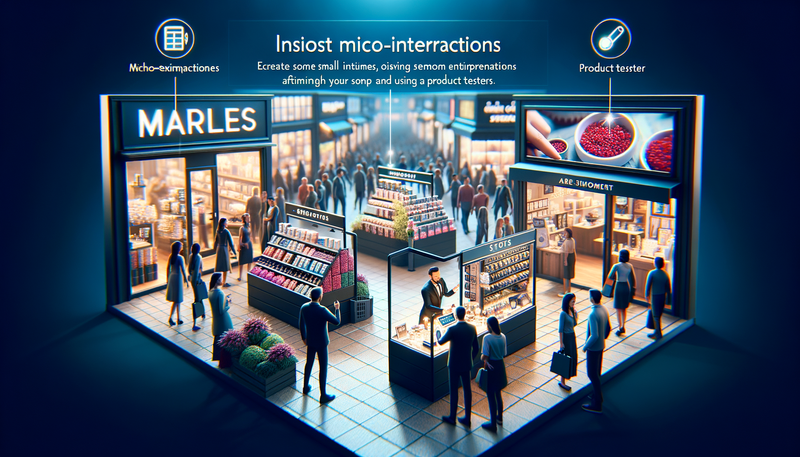Using Micro-Interactions to Enhance User Experience and Drive Sales
Micro-interactions are subtle design elements that can significantly enhance user experience and drive sales on e-commerce websites. These small, engaging interactions provide feedback, guide users, and create a more enjoyable browsing experience. By implementing well-designed micro-interactions, online retailers can improve user engagement, increase conversions, and ultimately boost their bottom line. This article explores the power of micro-interactions in e-commerce, offering insights into their benefits, types, and implementation strategies. Discover how these tiny design elements can make a big impact on your online store's success and learn practical tips for incorporating them into your website's user interface.Table of Contents:

Understanding Micro-Interactions in E-Commerce
Micro-interactions are small, subtle design elements that respond to user actions, providing feedback and enhancing the overall user experience. In e-commerce, these interactions can range from simple hover effects on product images to animated add-to-cart buttons. The primary goal of micro-interactions is to create a more engaging and intuitive interface, guiding users through the purchasing process and encouraging them to take desired actions.Effective micro-interactions in e-commerce serve multiple purposes: they provide visual feedback, confirm user actions, and create a sense of delight. By incorporating these elements thoughtfully, online retailers can create a more polished and professional-looking website while subtly influencing user behavior and increasing the likelihood of conversions.
Do you need a website? Want to build a website but don't know where to start? Our website builder is the perfect solution. Easy to use, and with the ability to customize to fit your business needs, you can have a professional website in no time.
The Benefits of Micro-Interactions for Online Stores
Implementing micro-interactions in your e-commerce website can yield numerous benefits. Firstly, they improve user engagement by making the browsing and shopping experience more interactive and enjoyable. This increased engagement can lead to longer session durations and higher chances of conversion.Secondly, micro-interactions enhance usability by providing instant feedback on user actions. This feedback helps users understand the results of their interactions, reducing confusion and frustration. Improved usability can lead to higher customer satisfaction and increased likelihood of repeat visits.
Lastly, well-designed micro-interactions can subtly guide users towards desired actions, such as adding items to their cart or proceeding to checkout. By making these processes more intuitive and visually appealing, e-commerce sites can increase their conversion rates and drive sales.
Types of Effective Micro-Interactions for E-Commerce
1. Hover Effects: Implement subtle animations or information displays when users hover over product images or buttons.2. Add-to-Cart Animations: Create visually appealing animations when users add items to their cart, confirming the action and encouraging further shopping.
3. Progress Indicators: Use visual cues to show users their progress through multi-step processes like checkout or account creation.
4. Real-time Form Validation: Provide instant feedback on form fields as users enter information, reducing errors and frustration.
5. Loading Animations: Implement engaging loading animations to keep users entertained during brief wait times.
6. Scroll-triggered Animations: Use subtle animations that activate as users scroll through product listings or long pages.
These micro-interactions can significantly enhance the user experience and guide visitors towards making a purchase when implemented effectively.
Building a website with SITE123 is easy
Implementing Micro-Interactions on Your E-Commerce Site
To implement micro-interactions on your e-commerce website, start by identifying key areas where user engagement can be improved. Focus on critical touch points in the user journey, such as product pages, shopping carts, and checkout processes.When designing micro-interactions, keep them subtle and purposeful. Avoid overwhelming users with excessive animations or effects that may distract from the primary goal of making a purchase. Ensure that the interactions align with your brand's visual identity and overall user experience.
Consider using CSS animations and transitions for simple micro-interactions, as they are lightweight and easy to implement. For more complex interactions, JavaScript libraries like GreenSock or Anime.js can be helpful. Always test your micro-interactions across different devices and browsers to ensure consistent performance and user experience.
Best Practices for E-Commerce Micro-Interactions
1. Keep it Simple: Micro-interactions should be subtle and not overpower the main content or functionality of your site.2. Ensure Consistency: Maintain a consistent style and behavior for micro-interactions throughout your website.
3. Provide Clear Feedback: Use micro-interactions to confirm user actions and provide clear, instant feedback.
4. Optimize Performance: Ensure that micro-interactions don't negatively impact your site's loading speed or overall performance.
5. Test and Iterate: Continuously test and refine your micro-interactions based on user feedback and analytics data.
6. Accessibility: Ensure that micro-interactions don't hinder accessibility for users with disabilities.
By following these best practices, you can create effective micro-interactions that enhance user experience and drive sales on your e-commerce website.





